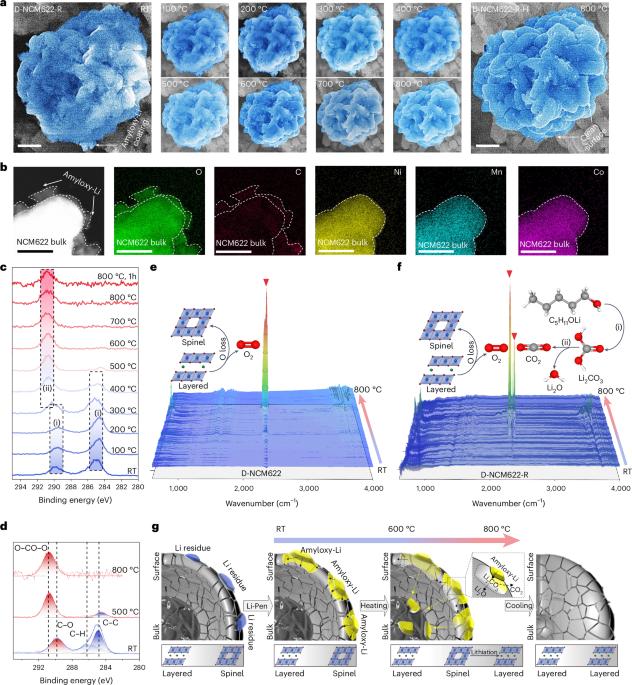在环境条件下通过自发锂化直接回收废阴极材料
IF 25.7
1区 环境科学与生态学
Q1 ENVIRONMENTAL SCIENCES
引用次数: 0
摘要
直接回收是对报废废正极进行可持续管理的一条大有可为的途径。然而,由于大多数现有方法在锂化步骤中需要加热或高压条件来克服热力学障碍并实现锂补充,因此其实际应用受到很大限制。在本研究中,我们探索了一种在环境条件下通过简单的固液混合实现自发锂化的策略。自吸附的淀粉基锂可以自发吸附在降解的正极颗粒表面,无需外部驱动力,从而降低了锂化反应的热力学障碍。这种策略既能再生实验室拆解的 10 Ah 袋装电池中的镍钴锰酸锂 0.6Co0.2Mn0.2O2,也能再生工业拆解的镍钴锰酸锂 0.5Co0.2Mn0.3O2黑块。使用再生的 LiNi0.5Co0.2Mn0.3O2 作为正极材料组装的 1 Ah 袋装电池在循环 500 次后的容量保持率为 80.5%。技术经济分析表明,与传统的火法和湿法冶金方法相比,所提出的策略具有很大的经济优势,同时还具有明显的环境效益,二氧化碳排放量的减少就证明了这一点。这项工作为直接回收废阴极材料提供了一种可行的方法,从而改善了电池行业的循环性。直接回收可促进报废废阴极的可持续管理,但却受到所需的苛刻操作条件的阻碍。自发锂化策略能够在环境条件下直接回收废阴极材料,具有明显的经济和环境效益。本文章由计算机程序翻译,如有差异,请以英文原文为准。

Direct recycling of spent cathode material at ambient conditions via spontaneous lithiation
Direct recycling is a promising route for the sustainable management of end-of-life spent cathodes. However, its practical implementation is greatly restricted as most existing methods require heating or high-pressure conditions during the lithiation step to overcome the thermodynamic obstacles and realize lithium replenishment. In this study, we explored a strategy to realize spontaneous lithiation via simple solid–liquid mixing at ambient conditions. The thermodynamic barrier of the lithiation reaction was reduced by self-adsorbed amyloxylithium, which can spontaneously adsorb on the surface of degraded cathode particles without an external driving force. This strategy can regenerate both laboratory-dismantled LiNi0.6Co0.2Mn0.2O2 from 10 Ah pouch cells and industrial-dismantled LiNi0.5Co0.2Mn0.3O2 black mass. The capacity retention rate of a 1 Ah pouch cell assembled using regenerated LiNi0.5Co0.2Mn0.3O2 as cathode material was 80.5% after 500 cycles. The proposed strategy has big economic advantages over conventional pyro- and hydrometallurgical methods, as evidenced by the techno-economic analysis, accompanied by obvious environmental benefits, as evidenced by reduced CO2 emissions. This work provides a viable approach for the direct recycling of spent cathode material, improving the circularity of the battery industry. Direct recycling can facilitate the sustainable management of end-of-life spent cathodes, but is hindered by the harsh operation conditions required. An spontaneous lithiation strategy enables direct recycling of spent cathode material at ambient conditions, with clear economic and environmental benefits.
求助全文
通过发布文献求助,成功后即可免费获取论文全文。
去求助
来源期刊

Nature Sustainability
Energy-Renewable Energy, Sustainability and the Environment
CiteScore
41.90
自引率
1.10%
发文量
159
期刊介绍:
Nature Sustainability aims to facilitate cross-disciplinary dialogues and bring together research fields that contribute to understanding how we organize our lives in a finite world and the impacts of our actions.
Nature Sustainability will not only publish fundamental research but also significant investigations into policies and solutions for ensuring human well-being now and in the future.Its ultimate goal is to address the greatest challenges of our time.
 求助内容:
求助内容: 应助结果提醒方式:
应助结果提醒方式:


